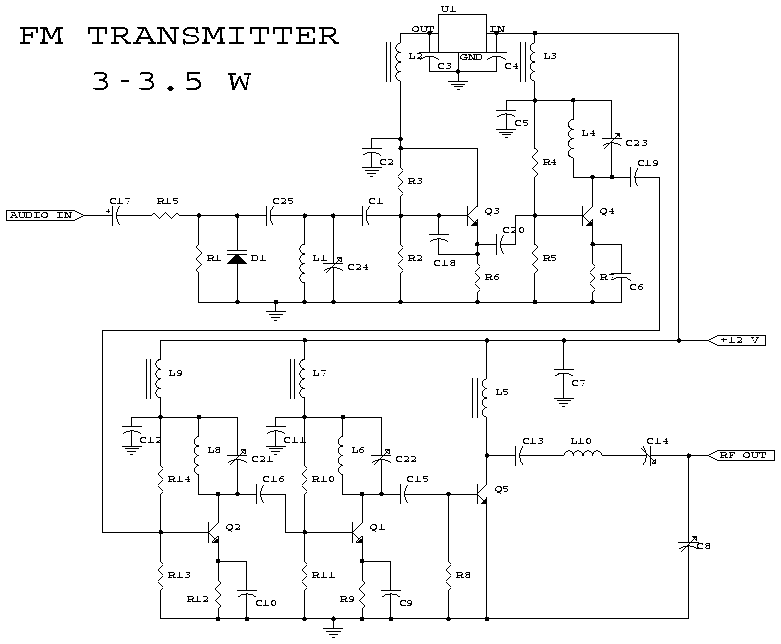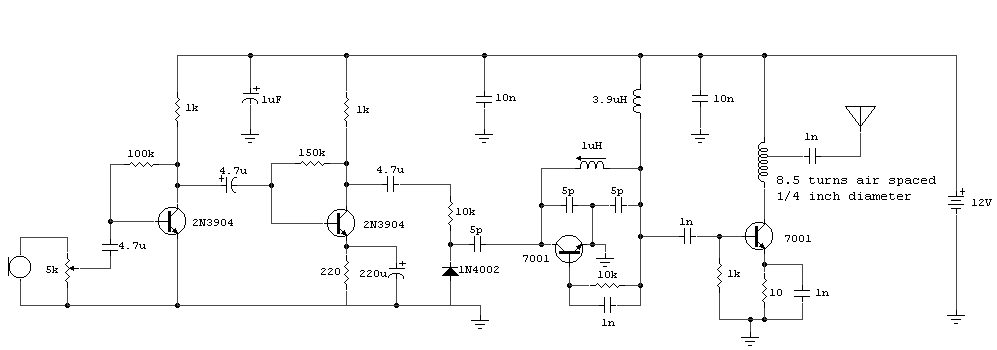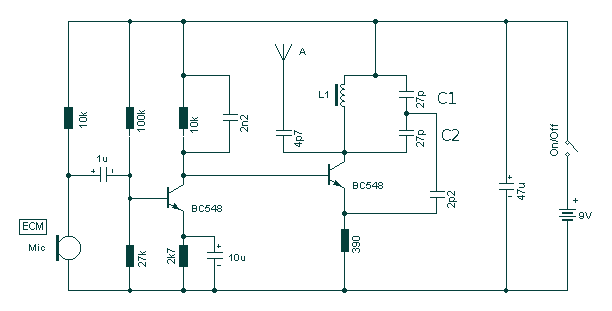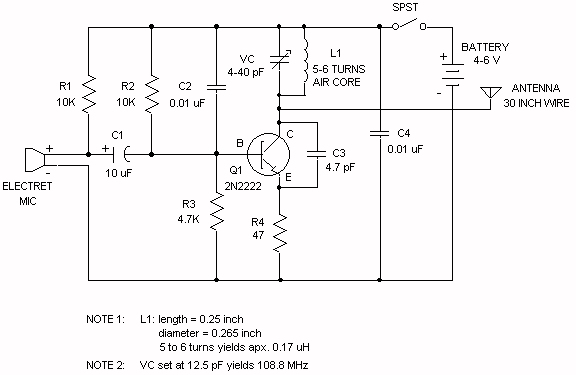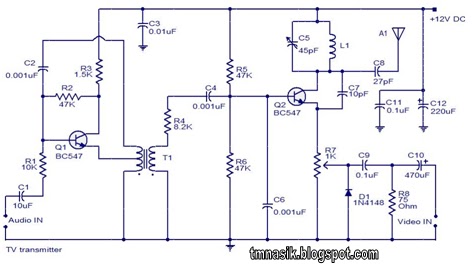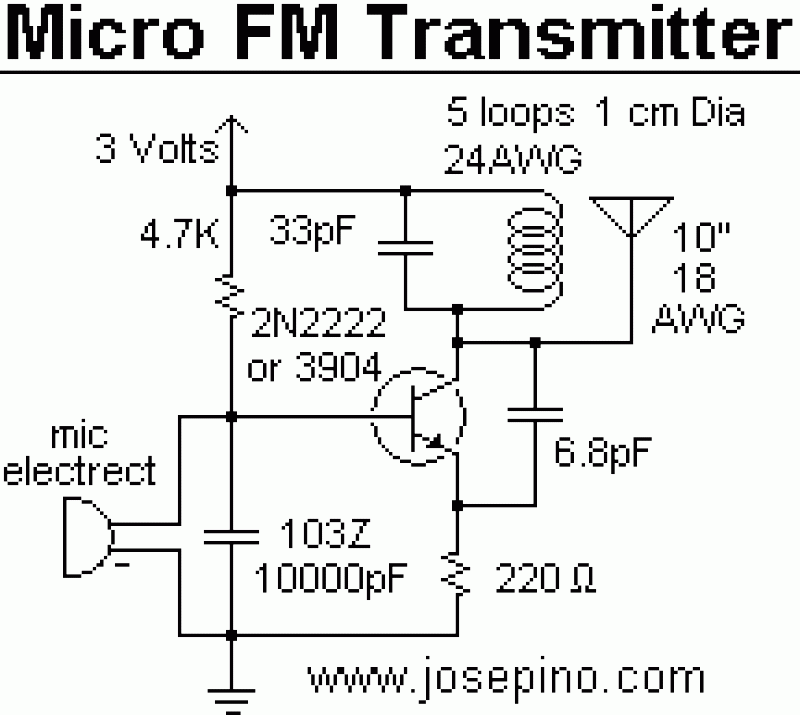
76MHz to 119MHz Fm transmitter

TR1 (BC547) is an inverted Hartley oscillator which based upon an inductor fabricated on the PCB. This makes it megga-stable, and setable anywhere in the VHF FM band (76MHz to 119MHz) and the BB105 varicap makes it voltage tuneable over about 8MHz of that band. The inductor has one tapping for feedback and a second to feed an optional prescaler. TR2 is a buffer/amplifier and TR3 it the PA stage. More: A single CD4046 and crystal oscillator can be used as a very simple PLL frequency controller for this transmitter with the frequency being determined by the crystal. I used this technique with the V6 transmitter so you have circuits available to suit your needs. The V7b acts as a simple 1.375MHz to 1.6875MHz external VCO for just about any "Single modulus" synthesiser, with MC (pin 2) = +5 volts. With MC=Gnd then it acts as a 1.354MHz to 1.662MHz VCO. The final TX output is 64 times the synth frequency with MC=+5v (65 with MC=Gnd). This means that it will operate with my simple CMOS synthesiser and give final frequency steps of 50KHz with the correct reference crystal (6.4MHz). With a "Dual Modulus" synthesiser, such as the MC145152-2, then the V7b will form a dual modulus synthesiser and can be controlled in steps of typically 5KHz. Only problem is that the chip costs more than the complete simple CMOS synthesiser.
The circuit described features a BC547 transistor (TR1) configured as an inverted Hartley oscillator. This design utilizes an inductor that is integrated directly onto the printed circuit board (PCB), enhancing stability and allowing for tuning across the VHF FM band, specifically from 76 MHz to 119 MHz. The use of a BB105 varicap diode provides voltage-controlled tuning capabilities, enabling adjustments over approximately 8 MHz within the specified band. The oscillator's feedback mechanism is facilitated by a tapping on the inductor, while an additional tap is available to connect an optional prescaler.
Following the oscillator stage, a second transistor (TR2) serves as a buffer/amplifier, improving signal integrity before it reaches the final power amplification stage (TR3). The inclusion of a CD4046 phase-locked loop (PLL) in conjunction with a crystal oscillator allows for straightforward frequency control of the transmitter. The frequency output of this PLL is determined by the selected crystal, providing a stable reference for the oscillator.
The V7b module operates as an external voltage-controlled oscillator (VCO) with a frequency range of 1.375 MHz to 1.6875 MHz when the modulation control (MC) pin is set to +5 volts. In contrast, when the MC pin is grounded, the VCO operates between 1.354 MHz and 1.662 MHz. The output frequency of the transmitter is significantly multiplied, achieving a final transmission frequency that is 64 times the VCO frequency when MC is high, and 65 times when MC is low. This configuration allows for operational compatibility with simple CMOS synthesizers, providing frequency steps of 50 kHz when paired with a 6.4 MHz reference crystal.
For applications requiring finer frequency resolution, the V7b can be integrated into a dual modulus synthesizer configuration, such as the MC145152-2. This setup enables control over frequency steps typically around 5 kHz, although the associated cost of the dual modulus chip is a consideration, as it may exceed the total price of a simpler CMOS synthesizer solution. TR1 (BC547) is an inverted Hartley oscillator which based upon an inductor fabricated on the PCB. This makes it megga-stable, and setable anywhere in the VHF FM band (76MHz to 119MHz) and the BB105 varicap makes it voltage tuneable over about 8MHz of that band. The inductor has one tapping for feedback and a second to feed an optional prescaler. TR2 is a buffer/amplifier and TR3 it the PA stage. A single CD4046 and crystal oscillator can be used as a very simple PLL frequency controller for this transmitter with the frequency being determined by the crystal. I used this technique with the V6 transmitter so you have circuits available to suit your needs. The V7b acts as a simple 1.375MHz to 1.6875MHz external VCO for just about any "Single modulus" synthesiser, with MC (pin 2) = +5 volts.
With MC=Gnd then it acts as a 1.354MHz to 1.662MHz VCO. The final TX output is 64 times the synth frequency with MC=+5v (65 with MC=Gnd). This means that it will operate with my simple CMOS synthesiser and give final frequency steps of 50KHz with the correct reference crystal (6.4MHz). With a "Dual Modulus" synthesiser, such as the MC145152-2, then the V7b will form a dual modulus synthesiser and can be controlled in steps of typically 5KHz.
Only problem is that the chip costs more than the complete simple CMOS synthesiser. 🔗 External reference
The circuit described features a BC547 transistor (TR1) configured as an inverted Hartley oscillator. This design utilizes an inductor that is integrated directly onto the printed circuit board (PCB), enhancing stability and allowing for tuning across the VHF FM band, specifically from 76 MHz to 119 MHz. The use of a BB105 varicap diode provides voltage-controlled tuning capabilities, enabling adjustments over approximately 8 MHz within the specified band. The oscillator's feedback mechanism is facilitated by a tapping on the inductor, while an additional tap is available to connect an optional prescaler.
Following the oscillator stage, a second transistor (TR2) serves as a buffer/amplifier, improving signal integrity before it reaches the final power amplification stage (TR3). The inclusion of a CD4046 phase-locked loop (PLL) in conjunction with a crystal oscillator allows for straightforward frequency control of the transmitter. The frequency output of this PLL is determined by the selected crystal, providing a stable reference for the oscillator.
The V7b module operates as an external voltage-controlled oscillator (VCO) with a frequency range of 1.375 MHz to 1.6875 MHz when the modulation control (MC) pin is set to +5 volts. In contrast, when the MC pin is grounded, the VCO operates between 1.354 MHz and 1.662 MHz. The output frequency of the transmitter is significantly multiplied, achieving a final transmission frequency that is 64 times the VCO frequency when MC is high, and 65 times when MC is low. This configuration allows for operational compatibility with simple CMOS synthesizers, providing frequency steps of 50 kHz when paired with a 6.4 MHz reference crystal.
For applications requiring finer frequency resolution, the V7b can be integrated into a dual modulus synthesizer configuration, such as the MC145152-2. This setup enables control over frequency steps typically around 5 kHz, although the associated cost of the dual modulus chip is a consideration, as it may exceed the total price of a simpler CMOS synthesizer solution. TR1 (BC547) is an inverted Hartley oscillator which based upon an inductor fabricated on the PCB. This makes it megga-stable, and setable anywhere in the VHF FM band (76MHz to 119MHz) and the BB105 varicap makes it voltage tuneable over about 8MHz of that band. The inductor has one tapping for feedback and a second to feed an optional prescaler. TR2 is a buffer/amplifier and TR3 it the PA stage. A single CD4046 and crystal oscillator can be used as a very simple PLL frequency controller for this transmitter with the frequency being determined by the crystal. I used this technique with the V6 transmitter so you have circuits available to suit your needs. The V7b acts as a simple 1.375MHz to 1.6875MHz external VCO for just about any "Single modulus" synthesiser, with MC (pin 2) = +5 volts.
With MC=Gnd then it acts as a 1.354MHz to 1.662MHz VCO. The final TX output is 64 times the synth frequency with MC=+5v (65 with MC=Gnd). This means that it will operate with my simple CMOS synthesiser and give final frequency steps of 50KHz with the correct reference crystal (6.4MHz). With a "Dual Modulus" synthesiser, such as the MC145152-2, then the V7b will form a dual modulus synthesiser and can be controlled in steps of typically 5KHz.
Only problem is that the chip costs more than the complete simple CMOS synthesiser. 🔗 External reference
